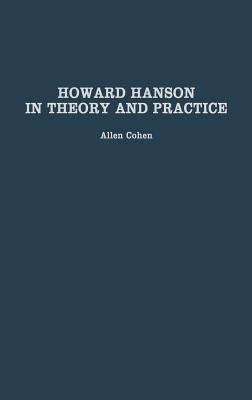
- We will send in 10–14 business days.
- Author: Allen Cohen
- Publisher: Praeger
- ISBN-10: 0313321353
- ISBN-13: 9780313321351
- Format: 16.3 x 24.3 x 2.2 cm, kieti viršeliai
- Language: English
- SAVE -10% with code: EXTRA
Reviews
Description
In this exciting new study of a largely overlooked but nevertheless extremely important figure in American music, author Allen Cohen explores the relationship between theory and practice in the works of Howard Hanson, a prominent twentieth-century composer, conductor, and educator. In Hanson's book Harmonic Materials of Modern Music, he proffered a theory of classification of all possible pitch-class collections in the chromatic scale, showing ways of deriving larger collections from smaller ones, and demonstrating significant relationships among them. This theory anticipated in many ways the standard formulations of music set theory, while also influencing Hanson's own compositions.
Following an introduction and biographical overview, Howard Hanson: Theory and Practice summarizes its subject's theoretical writings, examines their usefulness for both musicologists and composers, and analyzes in particular two of Hanson's musical pieces. In this way, Howard Hanson represents an exciting and highly educational look at a man and his work, both unacknowledged for too long.
EXTRA 10 % discount with code: EXTRA
The promotion ends in 21d.06:35:58
The discount code is valid when purchasing from 10 €. Discounts do not stack.
- Author: Allen Cohen
- Publisher: Praeger
- ISBN-10: 0313321353
- ISBN-13: 9780313321351
- Format: 16.3 x 24.3 x 2.2 cm, kieti viršeliai
- Language: English English
In this exciting new study of a largely overlooked but nevertheless extremely important figure in American music, author Allen Cohen explores the relationship between theory and practice in the works of Howard Hanson, a prominent twentieth-century composer, conductor, and educator. In Hanson's book Harmonic Materials of Modern Music, he proffered a theory of classification of all possible pitch-class collections in the chromatic scale, showing ways of deriving larger collections from smaller ones, and demonstrating significant relationships among them. This theory anticipated in many ways the standard formulations of music set theory, while also influencing Hanson's own compositions.
Following an introduction and biographical overview, Howard Hanson: Theory and Practice summarizes its subject's theoretical writings, examines their usefulness for both musicologists and composers, and analyzes in particular two of Hanson's musical pieces. In this way, Howard Hanson represents an exciting and highly educational look at a man and his work, both unacknowledged for too long.


Reviews